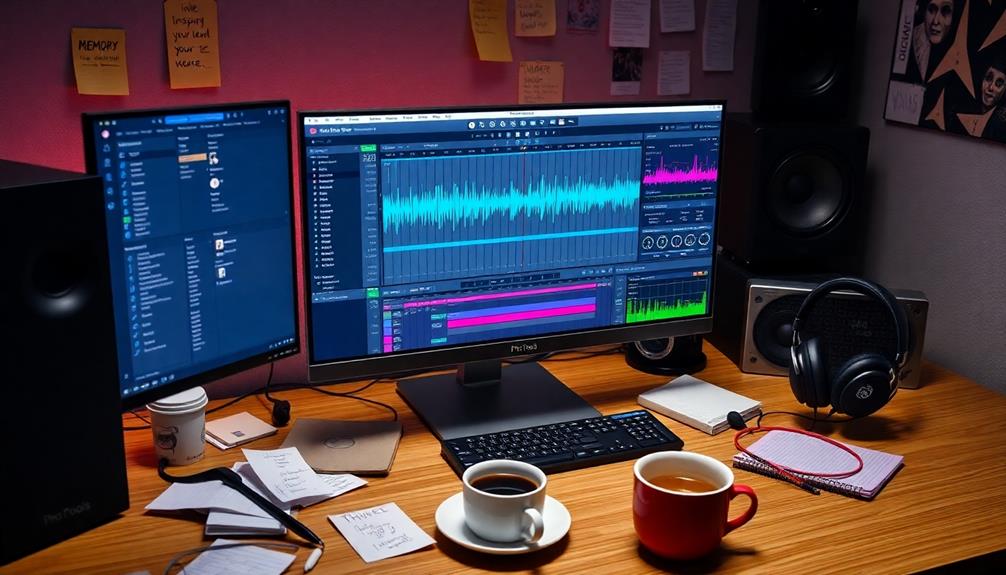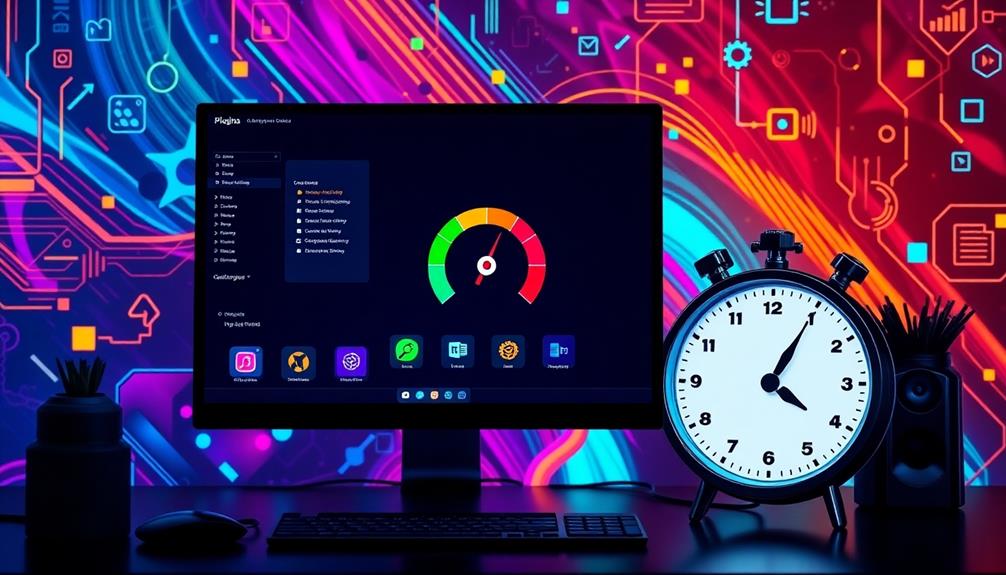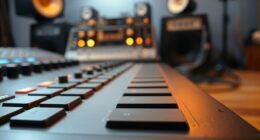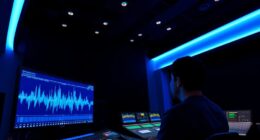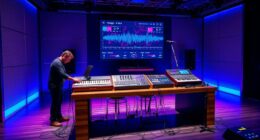To get the best results with click and backing tracks, rehearse extensively with them to build familiarity and confidence. Use proper monitoring so you can hear cues clearly and stay on tempo. Synchronize your backing tracks precisely with your live set, ensuring tight timing for a polished performance. Focus on maintaining consistent tempo and avoid disruptions. Want to master these techniques and elevate your playing? Keep going to discover essential practices to boost your synchronization skills.
Key Takeaways
- Rehearse thoroughly with both click and backing tracks to ensure seamless integration during live performance.
- Use high-quality monitoring equipment, like in-ear monitors, so performers can hear cues clearly.
- Synchronize backing tracks precisely with live set elements using reliable digital tools such as DAWs.
- Maintain consistent tempo and timing to prevent disruptions and enhance overall cohesion.
- Regularly review and adjust tracks based on performance feedback to improve accuracy and musicality.
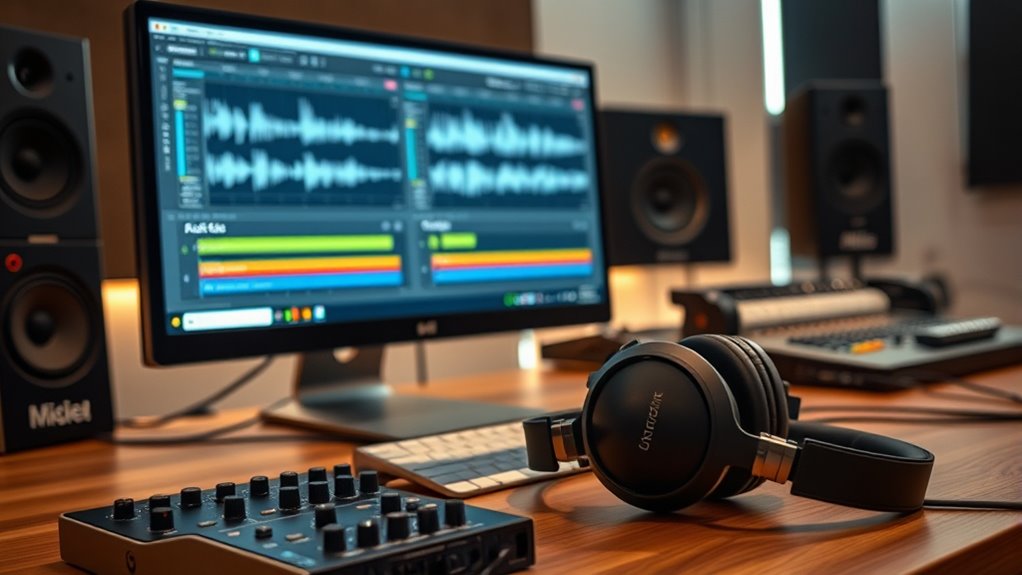
Have you ever wondered how musicians stay perfectly in sync during a live performance or recording? The secret often lies in music synchronization tools like click tracks and backing tracks. These tools serve as the backbone for maintaining timing accuracy and ensuring seamless live performance integration. When used correctly, they help you deliver tight, professional-sounding performances, whether you’re on stage or in the studio.
Music sync tools like click and backing tracks keep performances tight and professional.
A click track is essentially a steady metronome that plays a consistent tempo throughout a performance. It’s a pivotal element for keeping everyone on the same page, especially when multiple musicians are involved. By listening to the click, you can match your playing precisely to the beat, reducing timing errors and improving overall cohesion. When you incorporate a click track into your setup, you’re creating a shared sense of timing, which enhances music synchronization across the entire group. This is particularly important in live settings, where external variables like stage acoustics or performer nerves can throw off timing. Integrating a click track ensures that every musician stays locked in, making the performance feel polished and unified.
Live performance integration of click tracks requires some preparation. You need to ensure that all performers have in-ear monitors or appropriate cues so they can hear the click clearly without it bleeding into the audience. It’s also essential to rehearse with the click track beforehand, so musicians get comfortable with the tempo and feel confident in their timing. This practice helps prevent over-reliance on the click and encourages musicality, allowing performers to relax while maintaining synchronization. When everyone is familiar with the click, live performances become smoother, with fewer timing hiccups, and you can focus more on expression and interaction. Additionally, understanding the importance of timing is crucial, as even minor discrepancies can affect the overall performance quality.
Backing tracks extend this concept further by providing pre-recorded audio elements—like melodies, harmonies, or rhythm sections—that support live performers. When you use backing tracks, you’re effectively filling out your sound and creating a fuller, more engaging performance. Properly synchronized backing tracks contribute to music synchronization by aligning perfectly with live elements, avoiding timing discrepancies that can ruin the performance’s flow. To maximize live performance integration, you should synchronize backing tracks with your live set precisely, often using digital audio workstations (DAWs) or specialized playback devices. This ensures your backing tracks stay in perfect harmony with live musicians, elevating the overall quality of your performance.
Frequently Asked Questions
How Do I Choose the Right Click Track Tempo for My Song?
To choose the right click track tempo for your song, start by identifying the song’s natural pace and feel. Hum or tap along to find a comfortable rhythm, then set the track selection to match this tempo. Use a metronome or digital tools to fine-tune the song tempo, ensuring it supports the mood and energy you want. Consistency in tempo helps keep everyone synchronized and enhances your performance.
Can Backing Tracks Be Customized for Live Performances?
Backing tracks can definitely be customized for live performances, giving you the flexibility to adapt your set on the fly. I once saw a band tweak their backing tracks mid-show, adding extra layers for a more energetic feel. This highlights how live performance customization allows you to tailor backing tracks to match your vibe. With flexible backing tracks, you can adjust volume, add effects, or change sections seamlessly, enhancing your overall performance.
What Equipment Is Necessary to Synchronize Click and Backing Tracks?
To synchronize click and backing tracks, you’ll need a reliable audio interface and stage monitors. Connect your audio interface to your computer or playback device to send the tracks, then route the click track through stage monitors so performers can hear it clearly. Make certain your audio interface has low latency to keep everything in sync. Properly setting up and testing this setup ensures seamless playback during your live performance.
How Do I Prevent Latency Issues With Digital Backing Tracks?
To prevent latency issues with digital backing tracks, you should use a high-quality audio interface with low-latency drivers. Enable latency compensation in your DAW to sync tracks accurately. Keep buffer sizes as low as your system can handle without dropouts, and make sure your computer is optimized for audio production. Regularly update your drivers and software to guarantee minimal latency, giving you tight synchronization during performances.
Are There Software Options for Creating Professional Backing Tracks?
You can explore various software options to craft professional backing tracks that elevate your performances. Programs like Ableton Live, Logic Pro, and Cubase offer powerful tools to produce high-quality backing tracks tailored to your style. These options let you customize arrangements, add effects, and synchronize seamlessly with your live setup. Embracing the right software enhances your musical expression, turning simple ideas into polished, professional backing that captivates your audience effortlessly.
Conclusion
Now, as you refine your use of click and backing tracks, you might notice how seamlessly your performances come together. It’s almost like the perfect tempo and harmony align just when you need them most, making rehearsals feel effortless. Keep experimenting, and you’ll find that these tools not only enhance your sound but also create those spontaneous, magical moments on stage. Sometimes, the right track at the right time is all it takes to elevate your performance to the next level.



